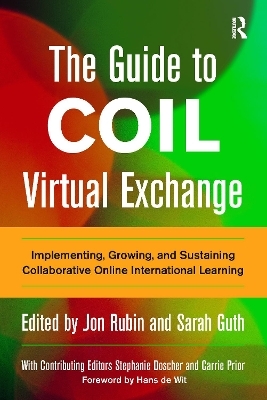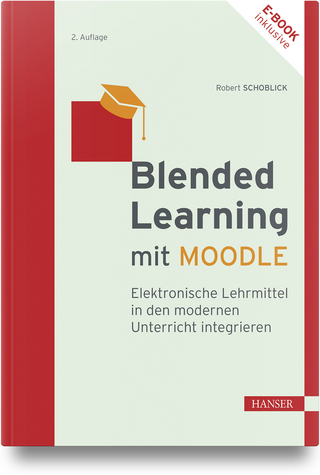
The Guide to COIL Virtual Exchange
Stylus Publishing (Verlag)
978-1-62036-983-8 (ISBN)
This is the authoritative guide to implementing COIL Virtual Exchange, conceived, and co-edited by one of the originators of this innovative approach to internationalization, Jon Rubin. COIL, the acronym for Collaborative Online International Learning, is a central modality of what has come to be known as virtual exchange. Since its first iteration in 2002, it has gradually established itself as a mature pedagogy that is being increasingly implemented across the world and is validated by a growing body of research. COIL Virtual Exchange at its most essential is a bi-lateral online exchange involving the integration of existing courses across two, or sometimes more, institutions that are geographically and/or culturally distinct. To launch a COIL VE course, the instructor of a class at a higher education institution in one location links online with a professor and his or her class in another region or country. Together, their students engage and develop joint projects, usually over a continuous five to eight-week period. Compared to the limited number of students worldwide who can engage in study abroad, COIL VE potentially opens up more equitable and inclusive participation in international education and intercultural experiences to all students, involves them in rigorous disciplinary and interdisciplinary studies, and promotes close and constructive engagement with students with different cultural perspectives.While many COIL courses are launched by individual instructors, based on their research connections and online outreach, they are being increasingly supported and led by dedicated COIL Coordinators who facilitate virtual exchanges and provide professional development. This comprehensive guide covers COIL VE pedagogy, provides examples of what takes place in the COIL classroom, and explores what instructors and staff need to know to facilitate and support a variety of COIL courses across the curriculum. It addresses how institutional stakeholders, especially those in leadership positions, can develop and embed a successful COIL initiative at their institution. It offers varied perspectives of COIL viewed from different institutional and cultural vantage points -- from research universities, community and technical colleges, and university systems -- and describes how COIL VE is developing in five different world regions, presenting eleven case studies.The book concludes with a guide to thirteen global organizations that support COIL and other forms of VE. Additionally, the book provides links to the COIL Connect for Virtual Exchange website (https://coilconnect.org) which includes an updated directory of organizations, an expanding database of faculty and institutions participating in COIL and looking for partners, course templates, survey data, and case studies.This book offers faculty and administrators across the world -- whether formally involved in international education, in service-learning and community engagement, or wanting to incorporate a cross-cultural perspective in their disciplinary courses -- theoretical foundations, guidance on effective collaboration, and the strategic and pedagogical considerations to develop robust COIL VE courses and programs.
Jon Rubin, founder and former director of SUNY’s COIL Center, is director of both COIL Consulting and COIL Connect for Virtual Exchange (https://coilconnect.org) a web initiative that supports institutions committed to COIL Virtual Exchange. He co-facilitated four iterations of the COIL Leadership Institute between 2017-2021, with the American Council on Education and later with Florida International University. Sarah Guth is the President of UNICollaboration, a cross-disciplinary professional organization for telecollaboration and virtual exchange in Higher Education, and teaches English as a Foreign Language at the University of Padova, Italy where she has implemented virtual exchange (VE) for two decades. She was the Program Coordinator at the SUNY COIL Center from 2013 to 2014. She currently focuses on the role of professional development in VE and the integration of VE into internationalization-at-home strategies. Stephanie Doscher is Director of Florida International University’s Office of Collaborative Online International Learning (FIU COIL). She also serves as Program Evaluator for the university’s Title VI-funded Kimberly Green Latin American and Caribbean National Resource Center. Stephanie’s work focuses primarily on organizational leadership and strategic planning, professional development, and integrative curricular and co-curricular design to enable global learning for all. Her research interests concern global learning instruction and assessment and the relationship between global learning, social innovation, and inclusive excellence. Stephanie advises a wide range of colleges and universities and presents engaging workshops for faculty and staff on methods for realizing their unique visions for transformative global learning. In addition to her co-authored article with Hilary Landorf, “Defining Global Learning at Florida International University,” recent publications include “Global Learning for Global Citizenship” in Human Developmen
List of Figures List of Tables List of Boxes Foreword—Hans de Wit How and Why the Guide to COIL Virtual Exchange is Linked to the COIL Connect for Virtual Exchange Website—Jon Rubin Survey Graphics Data Sources Utilized in this Book—Jon Rubin, Sarah Guth, and Alena Anishchanka Acknowlegments Part One. Introduction to COIL Virtual Exchange 1. Preface to an Evolving International Educational Landscape—Jon Rubin 2. The Limits of International Education Mobility and the Emergence of COIL—Harvey Charles 3. Situating COIL Virtual Exchange Within Concepts of Internationalization—Jos Beelen and Stephanie Doscher 4. Collaboration. Why It Is Central to COIL and How to Integrate It Into Practice—Jon Rubin Part Two. What Institutional Leaders, Senior International Officers, and Internationalization Champions Need to Know About COIL Virtual Exchange 5. Introduction—Jon Rubin 6. Preparing Your Institution to Develop an Equitable COIL VE Environment—Jon Rubin 7. Developing COIL Infrastructure and Forming a Core Team. Initial Steps—Jon Rubin 8. Developing Effective International Institutional Partnerships for COIL Virtual Exchange—Jon Rubin 9. Structuring COIL Activities from Start to Finish. Developing a 3-Year Plan—Jon Rubin 10. Taking COIL Virtual Exchange to Scale. 2004-2020—Jon Rubin, Katherine Wimpenny, BrendaGarcía Portillo, GianMario Besana, Eva Haug, Jami Leibowitz, Osvaldo Succi Jr., Albina Szeles, and Ruth O'Brien Part Three. What Instuctors and Support Staff Need to Know About COIL Virtual Exchange 11. Introduction to What Instructors and Support Staff Need to Know About COIL Virtual Exchange—Stephanie Doscher andJon Rubin 12. Strategies for Engaging Faculty With COIL Virtual Exchange—Sally Mudiamu 13. Professional Development for COIL Virtual Exchange. Why, How, and Who?—Stephanie Doscher 14. Professional Development for COIL Virtual Exchange. What Should It Entail?—Stephanie Doscher 15. Communicating Successfully Across Differences within COIL Virtual Exchange—Darla K. Deardorff 16. Assessing Intercultural Learning Outcomes in COIL Courses—Darla K. Deardorff 17. Matching Students. Strategies for Maximizing Inclusion and Success—Stephanie Tadal and Maria Marino 18. Information Technology Tools for COIL Virtual Exchange—Nicole Simon and Angélica Santana Fierro Part Four. Perspectives on COIL Virtual Exchange 19. COIL Development at State-funded U.S. University Systems—Dan Nolan 20. The Implementation and Sustainability of COIL at Research and Research-Aspiring Universities—Carrie Prior and Sake Jager 21. COILing at and With Community and Technical Colleges—Joan Landeros, Susan Jagendorf-Sobierajski, Kathleen M. McKenna, Lynda Carroll, Marcia Blackburn, Camila Maria da Costa Kami, Liesa Kyer, and Olga Aksakalova 22. COIL Country Focus—Thomas Buntru, BrendaGarcía Portillo,Verónica Rodríguez Luna,Ana Cristina Biondo Salomão, Osvaldo Succi Jr.,José Celso Freire Jr., Simone Hackett, Eva Haug, Keiko Ikeda, Veronica M. Onorevole, Lavern Samuels, Vinay Rajah, and Lize-Mari Mitchell 23. Organizations Supporting the Broader Virtual Exchange Field—Chesla Ann Lenkaitis Part Five. Case Studies. How Students, Teachers, and Other Learners Benefit 24. Case Studies. Voices of Students and Teachers—Elena Douvlou, Kelly Tzoumis,Giséle Manganelli Fernandes, John Shanahan, Nila Ginger Hofman, Shweta Sinha Deshpande, Christie A. Klimas, Odair Almeida, John R. Chapin, Fiona Rossette-Crake, Jon Rubin, Tuli Chatterji, Friyana Munshi, Kathryn Berlin, Khadija Rubaiyat Tasmia, Janiek de Vries, Rana Altayan, Tonnie van Genugten, and Steffanie M. Munguia Part Six. Conclusion. The Future of COIL and Networked Education 36. Conclusion—Jon Rubin Editors and Contributors Index
| Erscheinungsdatum | 03.10.2022 |
|---|---|
| Sprache | englisch |
| Maße | 152 x 229 mm |
| Gewicht | 381 g |
| Themenwelt | Schulbuch / Wörterbuch ► Unterrichtsvorbereitung ► Unterrichts-Handreichungen |
| Sozialwissenschaften ► Pädagogik ► Bildungstheorie | |
| Sozialwissenschaften ► Pädagogik ► Erwachsenenbildung | |
| ISBN-10 | 1-62036-983-4 / 1620369834 |
| ISBN-13 | 978-1-62036-983-8 / 9781620369838 |
| Zustand | Neuware |
| Informationen gemäß Produktsicherheitsverordnung (GPSR) | |
| Haben Sie eine Frage zum Produkt? |
aus dem Bereich


